英语必修二Unit1 Grammar导学案
- 格式:docx
- 大小:17.03 KB
- 文档页数:3
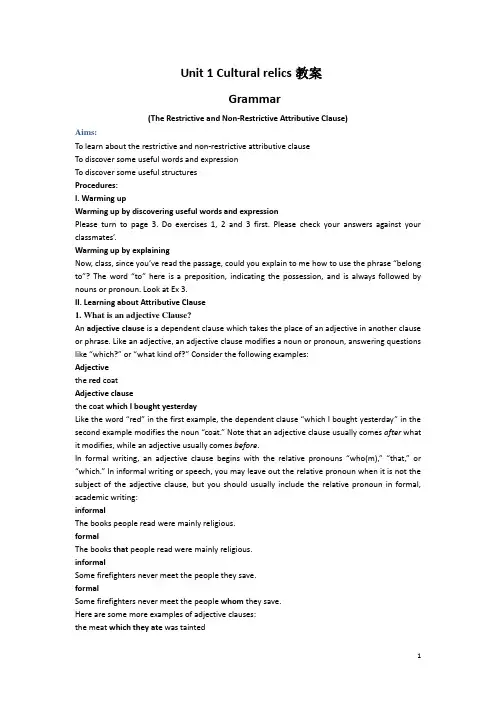
Unit 1 Cultural relics教案Grammar(The Restrictive and Non-Restrictive Attributive Clause)Aims:To learn about the restrictive and non-restrictive attributive clauseTo discover some useful words and expressionTo discover some useful structuresProcedures:I. Warming upWarming up by discovering useful words and expressionPlease turn to page 3. Do exercises 1, 2 and 3 first. Please check your answers against your classmates’.Warming up by explainingNow, class, since you’ve read the passage, could you explain to me how to use the phrase “belong to”? The word “to” here is a preposition, indicating the possession, and is always followed by nouns or pronoun. Look at Ex 3.II. Learning about Attributive Clause1. What is an adjective Clause?An adjective clause is a dependent clause which takes the place of an adjective in another clause or phrase. Like an adjective, an adjective clause modifies a noun or pronoun, answering questions like “which?” or “what kind of?” Consider the following examples:Adjectivethe red coatAdjective clausethe coat which I bought yesterdayLike the word “red” in the first example, the dependent clause “which I bought yesterday” in the second example modifies the noun “coat.” Note that an adjective clause usually comes after what it modifies, while an adjective usually comes before.In formal writing, an adjective clause begins with the relative pronouns “who(m),” “that,” or “which.” In informal writing or speech, you may leave out the relative pronoun when it is not the subject of the adjective clause, but you should usually include the relative pronoun in formal, academic writing:informalThe books people read were mainly religious.formalThe books that people read were mainly religious.informalSome firefighters never meet the people they save.formalSome firefighters never meet the people whom they save.Here are some more examples of adjective clauses:the meat which they ate was taintedThis clause modifies the noun “meat” and answers the question “which meat?”.They’re talking about the movie which made him cryThis clause modifies the noun “movie” and answers the question “which movie?”.They are searching for the student who borrowed the bookThe clause modifies the pronoun “student” and answers the question “which student?”.Did I tell you about the author whom I met?The clause modifies the noun “author” and answers the question “which author?”.2. Restrictive & non restrictive clausesDo the following pairs of sentences mean the same thing?1a My uncle, who lives in London, is very rich.2b My uncle who lives in London is very rich.2a The policies, which were unpopular, were rejected by the voters.2b The policies which were unpopular were rejected by the voters.3a My niece, whose husband is out of work, will inherit the house, which I have always treasured. 3b My niece whose husband is out of work will inherit the house which I have always treasured. The first sentence in each pair has a non-restrictive clause within two commas, and the second has a restrictive clause. A non-restrictive clause simply adds more information into the sentence and does not affect the meaning of the main clause: it is therefore bracketed off with commas (1a = an uncle who happens to live in London). Conversely, a restrictive clause defines its referent in the main clause more specifically and contributes significantly to the meaning of the sentence. Thus it is that particular uncle who lives in London who is referred to (1b). In 2a, all policies were unpopular and all were rejected, whereas in 2b only the policies that were unpopular were rejected. Note that in restrictive clauses the non-human relative pronoun is either ‘that’ or ‘which’, whereas for human referents the relative pronoun can be either ‘who/m’ or ‘that’ (the man that/whom I will marry ....).3. A test on FORMAL ADJECTIVE CLAUSESDirections: Combine the sentences. Use formal written English.Use (b) as an adjective clause. Punctuate carefully.1) (a) An antecedent is a word. (b) A pronoun refers to this word.An antecedent ____2) (a) The blue whale is considered the largest animal that has ever lived.(b) It can grow to 100 feet and 150 tons.The blue whale ____3) (a) The plane was met by a crowd of 300. (b) Some of them had been waiting for more than 4 hours.The plane ____4) (a) In this paper, I will describe the basic process.(b) Raw cotton becomes cotton thread by this process.In this paper, I will describe ____5) (a) The researchers are doing case studies of people to determine the importance of heredity in healt h and longevity.(b) These people’s families have a history of high blood pressure and heart disease.The researchers are doing case studies ____6) (a) At the end of this month, scientists at the institute will conduct their AIDS research. (b) Theresults of this research will be published within 6 months.At the end of this month, scientists ____7) (a) According to many education officials, ‘math phobia’(that is, a fear of mathematics) is a widespread problem. (b) A solution to this problem must and can be found.According to many education officials, ‘math phobia’ ____8) (a) The art museum hopes to hire a new administrator.(b) Under this person’s direction it will be able to purchase significant pieces of art.The art museum ____9) (a) The giant anteater licks up ants for its dinner.(b) Its tongue is longer than 30 centimeters (12 inches).The giant anteater ____10) (a) The anteater’s tongue is sticky.(b) It can go in and out of its mouth 160 times a minute.The anteater’s tongue ____III. Closing down by taking a quizQuiz on Attributive clauseSelect one answer from the choices provided after each sentence. The words you choose should fit the blank in the sentence. Don’t use the HINT buttons unless you really need them.1. As many children came were given some cakes.A. thatB. asC. whoD. whom2. The visitors saw rows of houses the roofs are red.A. on whichB. of whichC. whereD. that3. I usually take a nap after lunch, is my habit.A. which itB. as itC. asD. that4. Please tell me the way you did the job.A. howB. whereC. whichD. in which5 Is this museum some German friends visited the day before yesterday?A. the oneB. whichC. thatD. where6. The farmer uses wood to build a house to store grain.A. in whichB. whereC. thatD. with which7. I shall never forget the years I spent in the country with the farmers, has a great effect on my life.A. when, whichB. that, whichC. when, thatD. which, that8. Little has been done is helpful to our work.A. thatB. whatC. whichD. all that9. Perhaps this is the only market you can get such cheap goods.A. thatB. of whichC. by whichD. where10. We’ll put off the outing until next week, __we won’t be so busy.A. whenB. whichC. at whichD. in thatKey: 1~10:BBCDA ABADA。
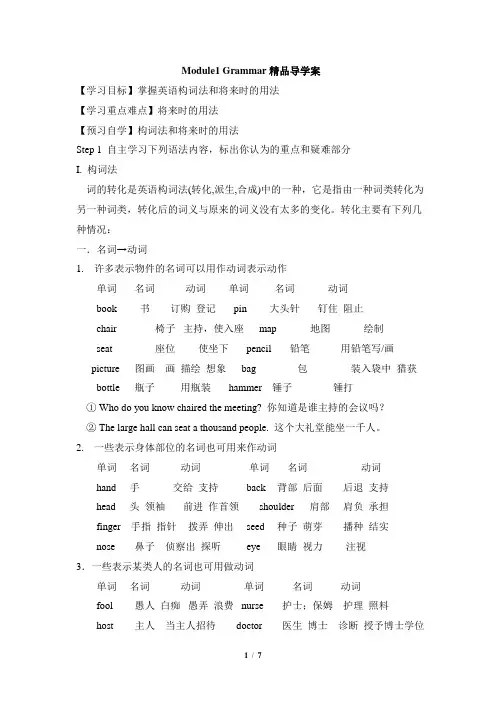
Module1 Grammar精品导学案【学习目标】掌握英语构词法和将来时的用法【学习重点难点】将来时的用法【预习自学】构词法和将来时的用法Step 1 自主学习下列语法内容,标出你认为的重点和疑难部分I. 构词法词的转化是英语构词法(转化,派生,合成)中的一种,它是指由一种词类转化为另一种词类,转化后的词义与原来的词义没有太多的变化。
转化主要有下列几种情况:一.名词→动词1. 许多表示物件的名词可以用作动词表示动作单词名词动词单词名词动词book 书订购登记pin 大头针钉住阻止chair 椅子主持,使入座map 地图绘制seat 座位使坐下pencil 铅笔用铅笔写/画picture 图画画描绘想象bag 包装入袋中猎获bottle 瓶子用瓶装hammer 锤子锤打① Who do you know chaired the meeting? 你知道是谁主持的会议吗?② The large hall can seat a thousand people. 这个大礼堂能坐一千人。
2. 一些表示身体部位的名词也可用来作动词单词名词动词单词名词动词hand 手交给支持back 背部后面后退支持head 头领袖前进作首领shoulder 肩部肩负承担finger 手指指针拨弄伸出seed 种子萌芽播种结实nose 鼻子侦察出探听eye 眼睛视力注视3.一些表示某类人的名词也可用做动词单词名词动词单词名词动词fool 愚人白痴愚弄浪费nurse 护士;保姆护理照料host 主人当主人招待doctor 医生博士诊断授予博士学位man 男人人类给…配备人员soldier 战士士兵当兵father 父亲前辈成为父亲mother 母亲母亲般地照顾;对...过分照顾① He fooled me into giving him money. 他欺骗我,要我给他钱② He insisted on staying up to nurse the child. 他坚持不睡觉来护理这个小孩。
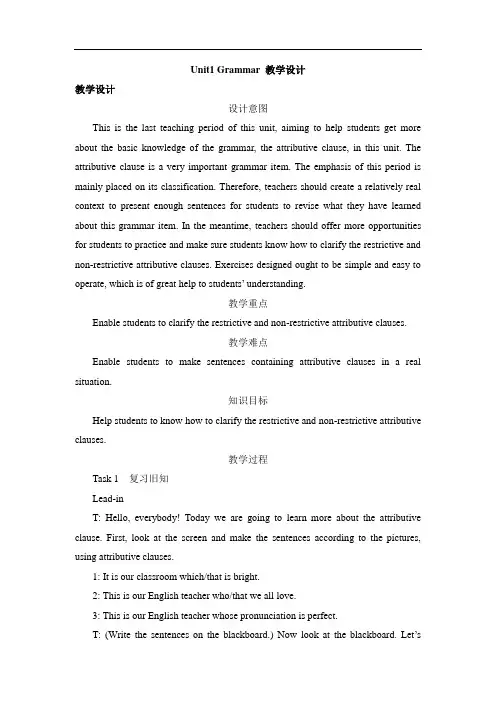
Unit1 Grammar 教学设计教学设计设计意图This is the last teaching period of this unit, aiming to help students get more about the basic knowledge of the grammar, the attributive clause, in this unit. The attributive clause is a very important grammar item. The emphasis of this period is mainly placed on its classification. Therefore, teachers should create a relatively real context to present enough sentences for students to revise what they have learned about this grammar item. In the meantime, teachers should offer more opportunities for students to practice and make sure students know how to clarify the restrictive and non-restrictive attributive clauses. Exercises designed ought to be simple and easy to operate, which is of great help to students’ understanding.教学重点Enable students to clarify the restrictive and non-restrictive attributive clauses.教学难点Enable students to make sentences containing attributive clauses in a real situation.知识目标Help students to know how to clarify the restrictive and non-restrictive attributive clauses.教学过程Task 1 复习旧知Lead-inT: Hello, everybody! Today we are going to learn more about the attributive clause. First, look at the screen and make the sentences according to the pictures, using attributive clauses.1: It is our classroom which/that is bright.2: This is our English teacher who/that we all love.3: This is our English teacher whose pronunciation is perfect.T: (Write the sentences on the blackboard.) Now look at the blackboard. Let’sanalyze these sentences.1. It is our classroom which/that is bright.↓↓main clause(主句) subordinate clause(从句)It is (our classroom) (which/that) is bright.↓attributive clause(定语从句)↓↓antecedent(先行词)relative pronoun (act as the subject in the attributive clause) (关系代词)2. This is (our English teacher) (who/that/whom) we all love.↓↓antecedent relative pronoun(act as the object in the attributive clause)3. This is our English teacher (whose) pronunciation is perfect.↓relative pronoun (act as the object in the attributive clause) Task 2 感受新知Ⅰ. More sentences from the textbookGive students several minutes to find out the antecedent and relative pronoun of each sentence,1. This gift was the Amber Room, which was given this name because several tons of amber were used to make it,2. The amber which was selected had a beautiful yellow-brown colour like honey.3. It was also a treasure decorated with gold and jewels, which took the country’s best artists about ten years to make.4. However, the next King of Prussia, Frederick William I, to whom the amber room belonged, decided not to keep it.5. Later, Catherine Ⅱhad the Amber Room moved to a palace outside St Petersburg where she spent her summers.6. This was a time when the two countries were at war.7. There is no doubt that the boxes were then put on a train for Konigsberg, which was at that time a German city on the Baltic Sea.Ⅱ. Conclusion定语从句有两种:(1) 限制性定语从句(先行词与定语从句间无逗号),如句子。
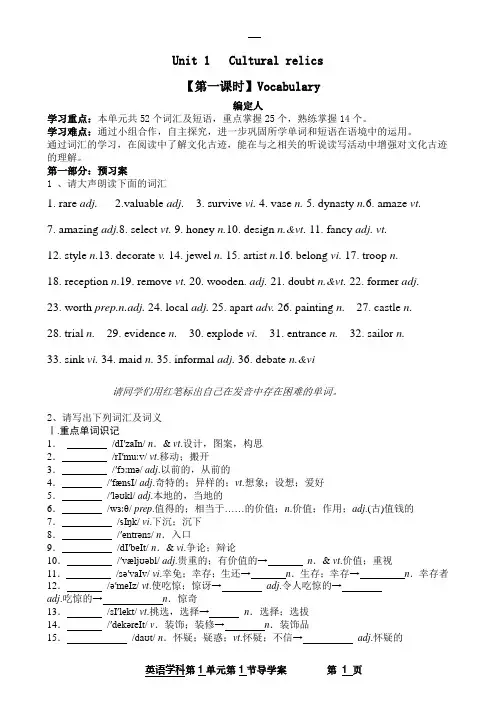
Unit 1 Cultural relics【第一课时】Vocabulary编定人学习重点:本单元共52个词汇及短语,重点掌握25个,熟练掌握14个。
学习难点:通过小组合作,自主探究,进一步巩固所学单词和短语在语境中的运用。
通过词汇的学习,在阅读中了解文化古迹,能在与之相关的听说读写活动中增强对文化古迹的理解。
第一部分:预习案1 、请大声朗读下面的词汇1. rare adj.2.valuable adj.3. survive vi.4. vase n.5. dynasty n.6. amaze vt.7. amazing adj.8. select vt. 9. honey n.10. design n.&vt. 11. fancy adj.vt.12. style n.13. decorate v. 14. jewel n. 15. artist n.16. belong vi. 17. troop n.18. reception n.19. remove vt. 20. wooden. adj. 21. doubt n.&vt. 22. former adj. 23. worth prep.n.adj. 24. local adj. 25. apart adv. 26. painting n.27. castle n.28. trial n. 29. evidence n. 30. explode vi. 31. entrance n.32. sailor n.33. sink vi. 34. maid n. 35. informal adj. 36. debate n.&vi请同学们用红笔标出自己在发音中存在困难的单词。
2、请写出下列词汇及词义Ⅰ.重点单词识记1./dI′zaIn/ n.& vt.设计,图案,构思2./rI′muːv/ vt.移动;搬开3./′fɔːmə/ adj.以前的,从前的4./′fænsI/ adj.奇特的;异样的;vt.想象;设想;爱好5./′ləʊkl/ adj.本地的,当地的6./wɜːθ/ prep.值得的;相当于……的价值;n.价值;作用;adj.(古)值钱的7./sIŋk/ vi.下沉;沉下8./′entrəns/ n.入口9./dI′beIt/ n.& vi.争论;辩论10./′væljʊəbl/ adj.贵重的;有价值的→n.& vt.价值;重视11./sə′vaIv/ vi.幸免;幸存;生还→n.生存;幸存→n.幸存者12./ə′meIz/ vt.使吃惊;惊讶→adj.令人吃惊的→adj.吃惊的→n.惊奇13./sI′lekt/ vt.挑选,选择→n.选择;选拔14./′dekəreIt/ v.装饰;装修→n.装饰品15./daʊt/ n.怀疑;疑惑;vt.怀疑;不信→adj.怀疑的英语学科第1单元第1节导学案第 1 页16./′evIdəns/ n.根据;证据→adj.明显的;清楚的17./Ik′spləʊd/ vi.爆炸→n.爆炸18./In′fɔːml/ adj.非正式的→(反义词) adj.正式的第二部分:训练案Ⅰ.语境填词1. Can I buy lunch for you ________________ (作为报答) for your help?2. This vase is valued ________________(少于) 40 dollars.3. Those two countries have been _________________(交战) for a long time.4. The machine has already been __________________(拆开).5. John mentioned several judges’ names, but he didn’t __________________(评价高) them.6. There is no _____________(怀疑)that he will get the first prize.7. Pandas are a kind of _____________ (珍希的)animals.8. That dictionary isn’t mine; it _____________ (属于)to the library.9. She is an able girl and she _______________(设计)all her dresses.10. I ______________ (想象)he’s pretty happy.11. She ______________(搬走) the painting to another wall.12. He bought me a _______________(贵重的)diamond ring as a birthday present.13. The great hall was _______________(装饰)with flowers.14. That novel isn’t w______________(值得)reading.15. Catherine works at the l______________(当地的) post office.Ⅱ.选词填空2.The police have received the letter and they are _____________it.3.I gave him some apples _____________ his help.4.The headmaster ______________me because of my good performance.5.Recently I’ve found a rare Qing Dynasty vase. But I don’t know whether it should______________me.6.The old man saw some Germans ________________ the Amber Room and moving it away.7.He is an explorer ___________ a sailor.8.When two countries were __________, troops of armies were sent to battlefront to fight.9.Much _________________, the task was finished in only one week.【课堂自测】单词拼写请根据汉语提示或首字母写出单词的正确形式1. The ________ (花瓶) belong to the Ming Dynasty.2. The Great Wall is one of the ___________ (奇迹) of the world.3. We are going to buy some __________ (家具) for our new house.4. You shouldn’t _________ (假装) to know what you don’t’ know.5. I don’t like the colour of the car. ___________ (而且), it’s too expensive.6. Train fares are likely to r________ unchanged. We can still buy cheap tickets.7. These houses are made of bricks and s_________.8. When h_________, the amber can be made into any shape.9. The family j_______ are locked in a safe.10.We should do everything we can to protect c__________ relics instead of destroying them.英语学科第1单元第1节导学案第 2 页。
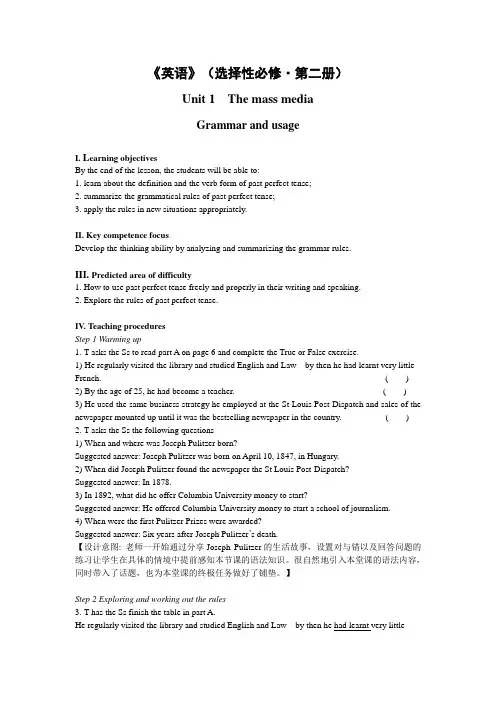
《英语》(选择性必修·第二册)Unit 1 The mass mediaGrammar and usageI. L earning objectivesBy the end of the lesson, the students will be able to:1. learn about the definition and the verb form of past perfect tense;2. summarize the grammatical rules of past perfect tense;3. apply the rules in new situations appropriately.II. Key competence focusDevelop the thinking ability by analyzing and summarizing the grammar rules.III. Predicted area of difficulty1. How to use past perfect tense freely and properly in their writing and speaking.2. Explore the rules of past perfect tense.IV. Teaching proceduresStep 1 Warming up1.T asks the Ss to read part A on page 6 and complete the True or False exercise.1)He regularly visited the library and studied English and Law---by then he had learnt very little French. ( )2)By the age of 25, he had become a teacher. ( )3)He used the same business strategy he employed at the St Louis Post-Dispatch and sales of the newspaper mounted up until it was the bestselling newspaper in the country. ( ) 2.T asks the Ss the following questions1)When and where was Joseph Pulitzer born?Suggested answer: Joseph Pulitzer was born on April 10, 1847, in Hungary.2)When did Joseph Pulitzer found the newspaper the St Louis Post-Dispatch?Suggested answer: In 1878.3)In 1892, what did he offer Columbia University money to start?Suggested answer: He offered Columbia University money to start a school of journalism.4)When were the first Pulitzer Prizes were awarded?Suggested answer: Six years after Joseph Pulitzer’s death.【设计意图: 老师一开始通过分享Joseph Pulitzer的生活故事,设置对与错以及回答问题的练习让学生在具体的情境中提前感知本节课的语法知识。
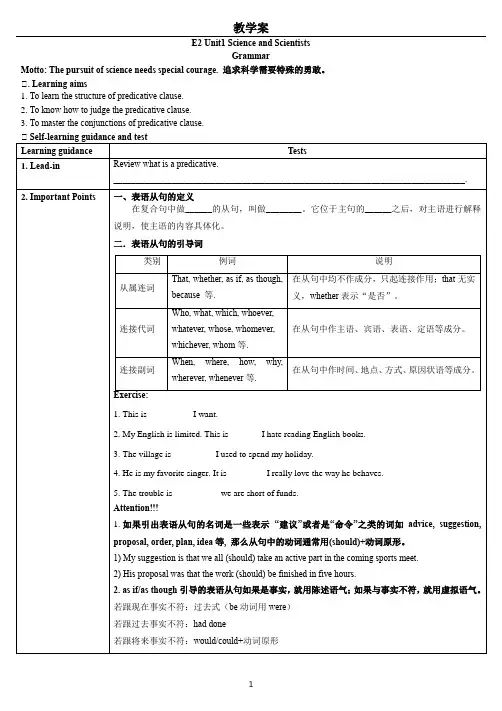
E2Unit1 Science and ScientistsGrammarMotto: The pursuit of science needs special courage. 追求科学需要特殊的勇敢。
Ⅰ. Learning aims1.To learn the structure of predicative clause.2.To know how to judge the predicative clause.3.To master the conjunctions of predicative clause.Ⅰ. ConsolidationLevel A 单句语法填空1.The truth is __________ we are lucky enough to have clean water whenever we want, but this is not the case for many people around the world.[浙江·月卷]2.This is __________ my father has taught me --- to always face difficulties and hope for the best.[北京卷]3.His advice to his grandma is________ she make good use of her spare time.4. The amazing thing about the spring is __________ the colder the temperature gets, the hotter the spring![2021·新高考I卷]5. What puzzles Lily’s friends is __________ always has so many crazy ideas.[2021天津卷]Level B Complete the sentences.1. The fact was____________________________________ . 事实是他没有真正的去尝试。
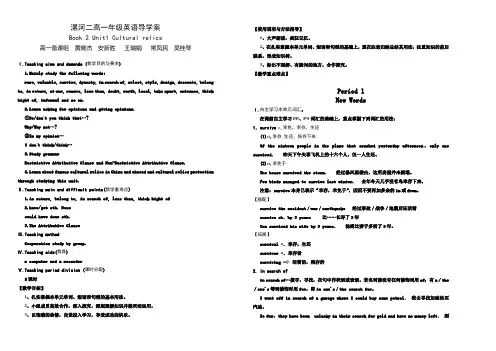
漯河二高一年级英语导学案Book 2 Unit1 Cultural relics高一备课组黄晓杰安新胜王瑞娟常凤民吴桂琴Ⅰ.Teaching aims and demands (教学目的与要求)1.Mainly study the following words:rare, valuable, survive, dynasty, in search of, select, style, design, decorate, belong to, in return, at war, remove, less than, doubt, worth, local, take apart, entrance, think hight of, informal and so on.2.Learn asking for opinions and giving opinions.①Do/don’t you think that…?Why/Why not…?②In my opinion…I don’t think/think…3.Study grammarRestrictive Attributive Clause and Non-Restrictive Attributive Clause.4.Learn about famous cultural relics in China and abroad and cultural relics protection through studying this unit.Ⅱ.Teaching main and difficult points(教学重难点)1.in ruturn, belong to, in search of, less than, think hight of2.have/get sth. Donecould have done sth.3.The Attributive ClauseⅢ.Teaching methodCooperation study by group.Ⅳ.Teaching aids(教具)a computer and a recorderⅤ.Teaching period division (课时分配)5课时【教学目标】1、扎实掌握本单元单词、短语和句型的基本用法。
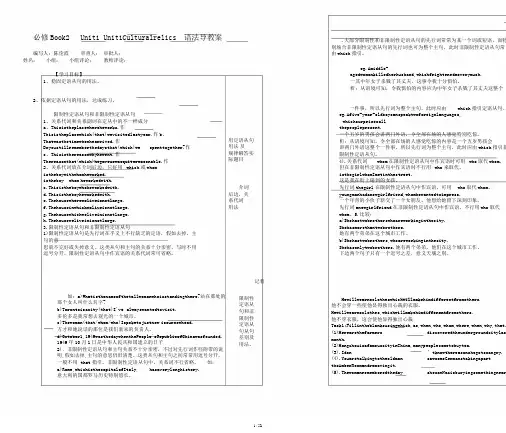
必修Book2 Unit1 Unit1Culturalrelics 语法导教案编写人:陈伦霞审查人:审批人:姓名:小组:小组评论:教师评论:【学习目标】1、稳固定语从句的用法。
.大部分限制性和非限制性定语从句的先行词常常为某一个词或短语,而特别场合非限制性定语从句的先行词也可为整个主句,此时非限制性定语从句常由which指引。
eg.Amiddle-agedwomankilledherhusband,whichfrightenedmeverymuch.一其中年女子杀戮了其丈夫,这事令我十分惧怕。
析:从语境可知,令我惧怕的内容应为中年女子杀戮了其丈夫这整个2、依据定语从句的用法,达成练习。
限制性定语从句和非限制性定语从句1、关系代词和关系副词在定从中的不一样成分a、Thisistheplacewhereheworks.作Thisistheplacewhich(that)wevisitedlastyear.作b、Thatwasthetimewhenhearrived.作Doyoustillrememberthedaysthat(which)we spenttogether?作c、Thisisthereasonwhyhewent.作Thereasonthat(which)hegaveuswasquitereasonable.作2、关系代词放在介词后边,只好用which或whom istheboywithwhomheworked.istheboy whom heworkedwith.c.Thisistheboywhoheworkedwith.d.Thisistheboyheworkedwith.e.Thehousewhereweliveisnotlarge.f.Thehouseinwhichweliveisnotlarge.g.Thehousewhichweliveinisnotlarge.h.Thehouseweliveinisnotlarge.3.限制性定语从句和非限制性定语从句1)限制性定语从句是先行词在乎义上不行缺乏的定语,假如去掉,主句的意思就不完好或失掉意义。
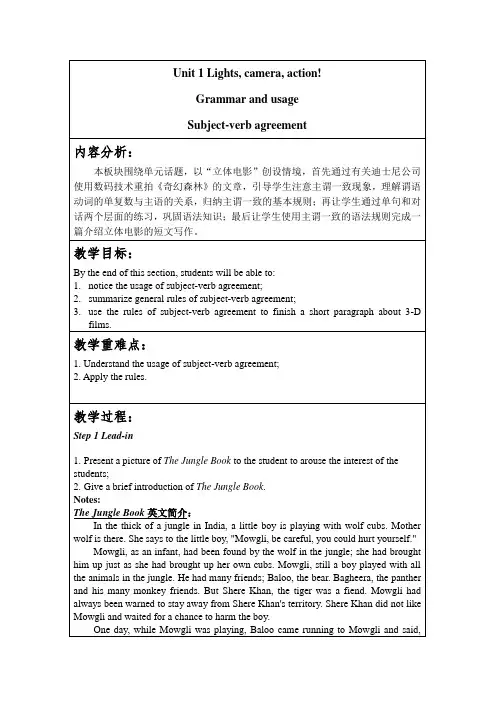
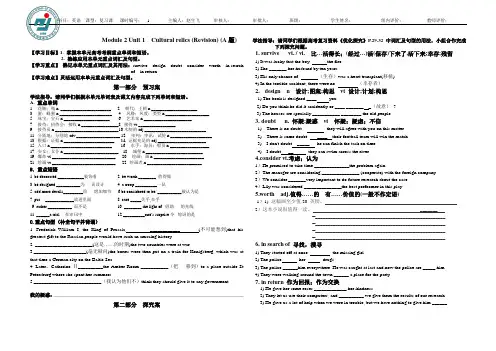
Module 2 Unit 1 Cultural relics (Revision) (A版)【学习目标】1. 掌握本单元高考考纲重点单词和短语。
2. 熟练应用本单元重点词汇及句型。
【学习重点】熟记本单元重点词汇及其用法:survive design doubt consider worth in searchof in return【学习难点】灵活运用本单元重点词汇及句型。
第一部分预习案学法指导:请同学们根据本单元单词表及课文内容完成下列单词和短语。
A. 重点单词1. 花瓶;瓶n. _______________________2. 朝代;王朝n._____________________3. 蜜;蜂蜜n.________________________4. 风格;风度;类型n.____________________5. 珠宝;宝石n._____________________6. 艺术家n.______________________7. 接待;招待会;接收n._________________8. 接待vt._________________9. 接待员n._____________________________10.木制的adj.____________________________11. 分离地;分别地adv.____________________ 12. 审判;审讯;试验n.___________________13. 根据;证据n._______________________ 14.证据充足的adj.______________________15. 入口n.____________________________ 16. 水手;海员;船员n.__________________17. 少女;女仆n._________________________ 18. 城堡n.__________________________19. 爆炸vi _____________________________ 20. 绘画;画n._______________________21. 绘画vt._____________________________ 22. 绘画者n._________________________B.重点短语1. be decorated ____________装饰着......2. be worth ________ 值得做3. be designed ___________为......而设计4. a troop __________一队5. add more details_________给......增加细节6.be considered to be/ ___________被认为是......7. put ... _____________放进里面8. care _____关乎,在乎9. rather ___________ 而不是10. ________ the light of...借助......的光线11. ______a trial 在审讯中12.__________one’s surprise令...惊讶的是C.重点句型(补全句子并背诵)1. Frederick William I, the King of Prussia, ____________ (不可能想到)that his greatest gift to the Russian people would have such an amazing history.2. _______________________(这是……的时期)the two countries were at war.3._____________________(毫无疑问)the boxes were then put on a train for Konigsberg, which was at that time a German city on the Baltic Sea.4. Later,Catherine Ⅱ__________the Amber Room ___________(把......移到)to a place outside St Petersburg where she spent her summers.5.___________________________(我认为他们不)think they should give it to any government.我的疑惑:____________________________________________________________________________第二部分探究案学法指导:请同学们根据高考复习资料《优化探究》P.29-32中词汇及句型的用法,小组合作完成下列探究问题。
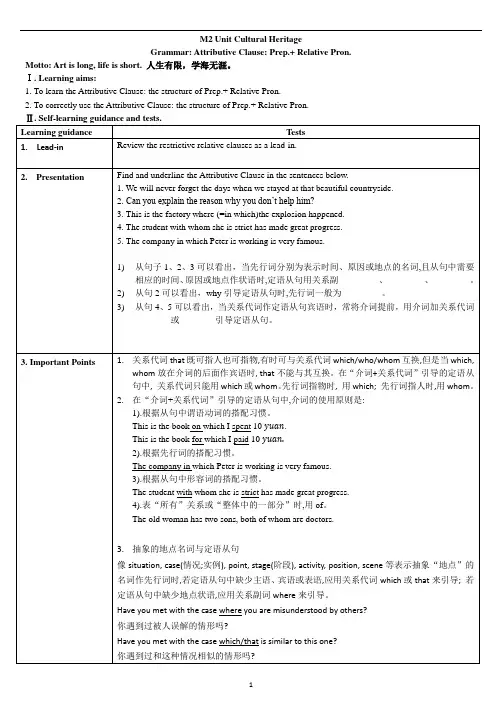
M2 Unit Cultural HeritageGrammar: Attributive Clause: Prep.+ Relative Pron.Motto: Art is long, life is short. 人生有限,学海无涯。
Ⅰ. Learning aims:1. To learn the Attributive Clause: the structure of Prep.+ Relative Pron.2. To correctly use the Attributive Clause: the structure of Prep.+ Relative Pron.Learning guidance Tests1. Lead-in Review the restrictive relative clauses as a lead-in._________________________________________________________________2. Presentation Find and underline the Attributive Clause in the sentences below.1. We will never forget the days when we stayed at that beautiful countryside.2. Can you explain the reason why you don’t help him?3. This is the factory where (=in which)the explosion happened.4. The student with whom she is strict has made great progress.5. The company in which Peter is working is very famous.1)从句子1、2、3可以看出,当先行词分别为表示时间、原因或地点的名词,且从句中需要相应的时间、原因或地点作状语时,定语从句用关系副_________、_________、_________。
必修II Unit1 Cultural relics 导学案 第一课时: Grammar(Attributive clause)知识目标:1.Master the attributive clause and tell the differences between them. 2. The ability of using proper relative words.能力目标:1.Enable students to tell the differences between them. 2.Enable students to use proper relative words.情感目标:e the Attributive clause properly in our daily life.课前自主预习方案定语从句根据其与先行词的关系,可分为限制性定语从句与非限制性定语从句,二者【观察总结】 观察下列几组定语从句,试着归纳总结其规律并填空。
①In China, the Spring Festival is a grand holiday when family members get together. ②In China, the Spring Festival is a grand holiday, when family members get together. 观察上面一组例句可知:①句是由_____引导的_____定语从句,先行词为_____。
可译为:在中国,春节是一个家人团聚的隆重的节日。
②句是由_____引导的_____定语从句,先行词为_____,可译为:在中国,春节是一个隆重的节日,届时家人们都会团聚在一起。
③The old couple has a son who works in a big company. ④The old couple has a son, who works in a big company. 观察上面一组例句可知:③句是由_____引导的_____定语从句,先行词为_____,此处,who 可以用that 代替。
高中英语人教版选择性必修第二册unit 1 Grammar表语从句(ThePredicative Clause)一、表语从句的定义:表语从句就是用一个句子作为表语,放在连系动词之后,充当复合句中的表语,用来说明主语是什么或者怎么样。
The problem is puzzling.主语连系动词形容词作表语The problem is when we can get a pay rise. 主语连系动词一个句子作表语一表语从句二、表语从句的构成:系动词+引导词+简单句What I want to say is that I am tired.三、表语从句的用法.可按表语从句的连系动词有:1).最常用连系动词:be(am; is/was; are/were)o一般在句子中译成:“ 日”7E ...China is no longer what she used to be.2).表变化的系动词:get; turn; go; fall; become; grow; come; run。
用法注意:在英语中,系动词一般只有一般现在时和一般过去时两种时态变化形式,没有其他时态变化形式。
但表变化的这类系动词除外,它们有各种时态变化。
It is becoming colder and colder. The food has gone bad.此处还需注意的是become和turn后接表职业的名词时冠词的有无:Two years later, he became a teacher.但Two years later, he turned teacher.另外,g。
表变化时一般指事情向消极、不好的方面转化。
3).所谓“感官动词”:look; sound; ta ste; smell; fbeL般它们在句子中译成:“・・・起来; ...上去”。
此类系动词为高考高频词。
The food tasted good.食物尝起来很香。
高中英语 Unit 2 Grammar导学案新人教版必修2Unit2 Grammar导学案新人教版必修2 英语中的分词有两种:现在分词和过去分词,兼有动词、副词和形容词的特征。
在句子中可以作定语,表语,宾语补足语和状语。
考点一现在分词的基本形式及物动词(do)不及物动词(go)主动语态被动语态主动语态一般式doingbeing donegoing完成式having donehaving been donehaving gone1、现在分词的一般式一般式所表示的动作与谓语动词所表示的动作一般同时进行。
如:They came in talking and laughing、他们谈笑着进来了。
S eeing nobody there,he turned off the lights、看到没人在那,他就把灯关了。
2、现在分词的完成式完成式表示的动作发生在谓语动词的动作之前。
如:Having cleaned the desks,we began reading、擦完了桌子后,我们便开始看书。
H aving been surrounded for a month,the enemy had to give in、被包围一个月后,敌人不得不投降了。
3、现在分词的被动语态现在分词的被动语态分为一般式和完成式两种。
一般式表示一个被动动作正在进行。
或与谓语表示的动作同时进行。
完成式表示一个被动动作在谓语表示的动作之前已经完成了。
如:The building being built will be our school library、正在建造的那座大楼将是我们的校图书馆。
[例] ____ ,we were taken to Bee the library、A、We had been shown the classroomsB、Being shown the classroomsC、Having been shown the classroomsD、Having shown the classrooms[解析] 句意:我们先被领着看了教室,又被带去看图书馆。
人教版高中英语必修二unit1教案以下是一份人教版高中英语必修二unit1的教案模板,供您参考:一、教学目标1. 知识目标:掌握本单元的重点词汇和短语,如“access”,“available”,“click”,“database”等。
2. 能力目标:能够理解和运用本单元所学的词汇和语法结构,提高阅读和写作能力,并能够在实际生活中运用所学知识进行交流。
3. 情感目标:培养学生对科技发展的认识和兴趣,激发他们探索新技术的热情。
二、教学内容本单元主题是“科技发展”,主要介绍了互联网和人工智能的发展和应用。
通过本单元的学习,学生将了解互联网和人工智能的基本概念和发展历程,以及它们在各个领域的应用和影响。
三、教学重点与难点1. 教学重点:掌握本单元的重点词汇和短语,理解课文中的长句和难句。
2. 教学难点:理解课文中的抽象概念和深入思考科技发展的影响和利弊。
四、教具和多媒体资源1. 黑板:用于书写重点词汇和句型。
2. 投影仪:播放PPT和相关视频资料。
3. 教学软件:提供在线学习资源和互动练习。
五、教学方法1. 激活学生的前知:通过提问和讨论,了解学生对科技发展的已有认知。
2. 教学策略:采用讲解、示范、小组讨论、案例分析等多种教学方法,帮助学生理解和运用所学知识。
3. 学生活动:组织学生进行小组讨论、角色扮演等活动,提高他们的参与度和实践能力。
六、教学过程1. 导入(5分钟)通过提问导入新课:“你们平时上网都做什么?”引导学生回答,引出互联网的概念和应用。
再问:“你们知道互联网的发展历程吗?”引导学生思考,引出本单元的主题。
2. 呈现新知(15分钟)通过PPT展示互联网和人工智能的发展历程和应用领域,同时讲解课文中的重点词汇和语法结构。
在讲解过程中,引导学生关注课文中的长句和难句,帮助他们理解抽象概念。
3. 巩固练习(10分钟)提供相关练习题,如词汇翻译、句子改写等,帮助学生巩固所学知识。
同时组织学生进行小组讨论,探讨科技发展对生活和工作的影响和利弊。